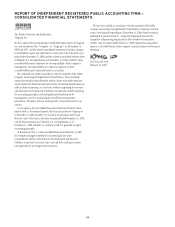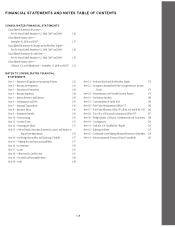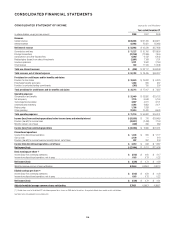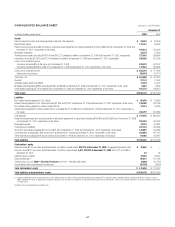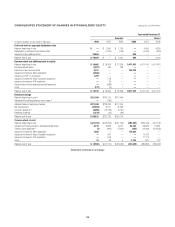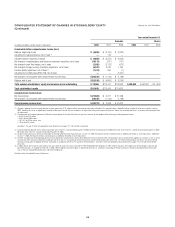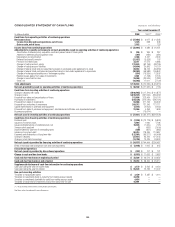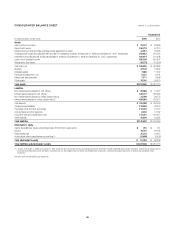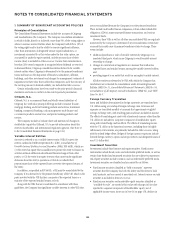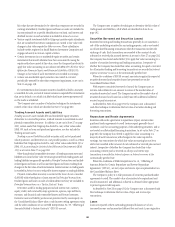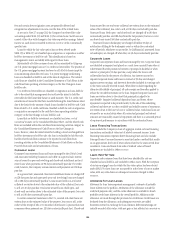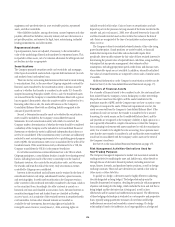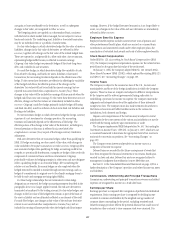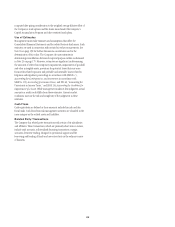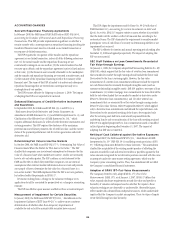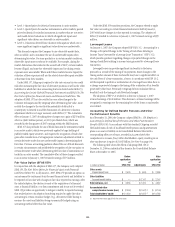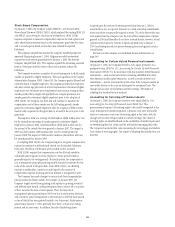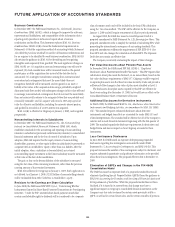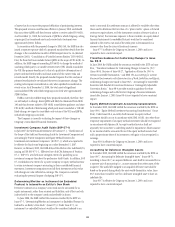Citibank 2008 Annual Report Download - page 130
Download and view the complete annual report
Please find page 130 of the 2008 Citibank annual report below. You can navigate through the pages in the report by either clicking on the pages listed below, or by using the keyword search tool below to find specific information within the annual report.fees and certain direct origination costs are generally deferred and
recognized as adjustments to income over the lives of the related loans.
As set out in Note 27 on page 202, the Company has elected fair value
accounting under SFAS 159 and SFAS 155 for certain loans. Such loans are
carried at fair value with changes in fair value reported in earnings. Interest
income on such loans is recorded in Interest revenue at the contractually
specified rate.
Loans for which the fair value option has not been elected under
SFAS 159 or SFAS 155 are classified upon origination or acquisition as either
held-for-investment or held-for-sale. This classification is based on
management’s intent and ability with regard to those loans.
Substantially all of the consumer loans sold or securitized by Citigroup
are U.S. prime mortgage loans or U.S. credit card receivables. The practice of
the U.S. prime mortgage business has been to sell all of its loans except for
nonconforming adjustable rate loans. U.S. prime mortgage conforming
loans are classified as held-for-sale at the time of origination. The related
cash flows are classified in the Consolidated Statement of Cash Flows in the
cash flows from operating activities category on the line Change in loans
held-for-sale.
U.S. credit card receivables are classified at origination as loans-held-for
sale to the extent that management does not have the intent to hold the
receivables for the foreseeable future or until maturity. The U.S. credit card
securitization forecast for the three months following the latest balance sheet
date is the basis for the amount of such loans classified as held-for-sale. Cash
flows related to U.S. credit card loans classified as held-for-sale at origination
or acquisition are reported in the cash flows from operating activities
category on the line Change in loans held-for-sale.
Loans that are held-for-investment are classified as Loans, net of
unearned income on the Consolidated Balance Sheet, and the related cash
flows are included within the cash flows from investing activities category in
the Consolidated Statement of Cash Flows on the line Changes in
loans. However, when the initial intent for holding a loan has changed from
held-for-investment to held-for-sale, the loan is reclassified to held-for-sale,
but the related cash flows continue to be reported in cash flows from
investing activities in the Consolidated Statement of Cash Flows on the line
Proceeds from sales and securitizations of loans.
Consumer Loans
Consumer loans represent loans and leases managed by the Global Cards
and Consumer Banking businesses and GWM. As a general rule, interest
accrual ceases for open-end revolving and closed-end installment and real
estate loans when payments are 90 days contractually past due. For credit
cards, however, the Company accrues interest until payments are 180 days
past due.
As a general rule, unsecured closed-end installment loans are charged off
at 120 days past due and unsecured open-end (revolving) loans are charged
off at 180 days contractually past due. Loans secured with non-real-estate
collateral are written down to the estimated value of the collateral, less costs
to sell, at 120 days past due. Real-estate secured loans (both open- and
closed-end) are written down to the estimated value of the property, less costs
to sell, at 180 days contractually past due.
In certain consumer businesses in the U.S., secured real estate loans are
written down to the estimated value of the property, less costs to sell, at the
earlier of the receipt of title or 12 months in foreclosure (a process that must
commence when payments are 120 days contractually past due). Closed-end
loans secured by non-real-estate collateral are written down to the estimated
value of the collateral, less costs to sell, at 180 days contractually past due.
Unsecured loans (both open- and closed-end) are charged off at 180 days
contractually past due and 180 days from the last payment, but in no event
can these loans exceed 360 days contractually past due.
Unsecured loans in bankruptcy are charged off within 30 days of
notification of filing by the bankruptcy court or within the contractual
write-off periods, whichever occurs earlier. In CitiFinancial, unsecured loans
in bankruptcy are charged off when they are 30 days contractually past due.
Corporate Loans
Corporate loans represent loans and leases managed by ICG. Corporate loans
are identified as impaired and placed on a cash (non-accrual) basis when it
is determined that the payment of interest or principal is doubtful or when
interest or principal is 90 days past due, except when the loan is well
collateralized and in the process of collection. Any interest accrued on
impaired corporate loans and leases is reversed at 90 days and charged
against current earnings, and interest is thereafter included in earnings only
to the extent actually received in cash. When there is doubt regarding the
ultimate collectibility of principal, all cash receipts are thereafter applied to
reduce the recorded investment in the loan. Impaired corporate loans and
leases are written down to the extent that principal is judged to be
uncollectible. Impaired collateral-dependent loans and leases, where
repayment is expected to be provided solely by the sale of the underlying
collateral and there are no other available and reliable sources of repayment,
are written down to the lower of cost or collateral value. Cash-basis loans are
returned to an accrual status when all contractual principal and interest
amounts are reasonably assured of repayment and there is a sustained period
of repayment performance in accordance with the contractual terms.
Lease Financing Transactions
Loans include the Company’s share of aggregate rentals on lease financing
transactions and residual values net of related unearned income. Lease
financing transactions represent direct financing leases and also include
leveraged leases. Unearned income is amortized under a method that results
in an approximate level rate of return when related to the unrecovered lease
investment. Gains and losses from sales of residual values of leased
equipment are included in Other revenue.
Loans Held-for-Sale
Corporate and consumer loans that have been identified for sale are
classified as loans held-for-sale included in Other assets. With the exception
of certain mortgage loans for which the fair-value option has been elected
under SFAS 159, these loans are accounted for at the lower of cost or market
value, with any write-downs or subsequent recoveries charged to Other
revenue.
Allowance for Loan Losses
Allowance for loan losses represents management’s estimate of probable
losses inherent in the portfolio. Attribution of the allowance is made for
analytical purposes only, and the entire allowance is available to absorb
probable credit losses inherent in the overall portfolio. Additions to the
allowance are made through the provision for credit losses. Credit losses are
deducted from the allowance, and subsequent recoveries are added.
Securities received in exchange for loan claims in debt restructurings are
initially recorded at fair value, with any gain or loss reflected as a recovery or
124


